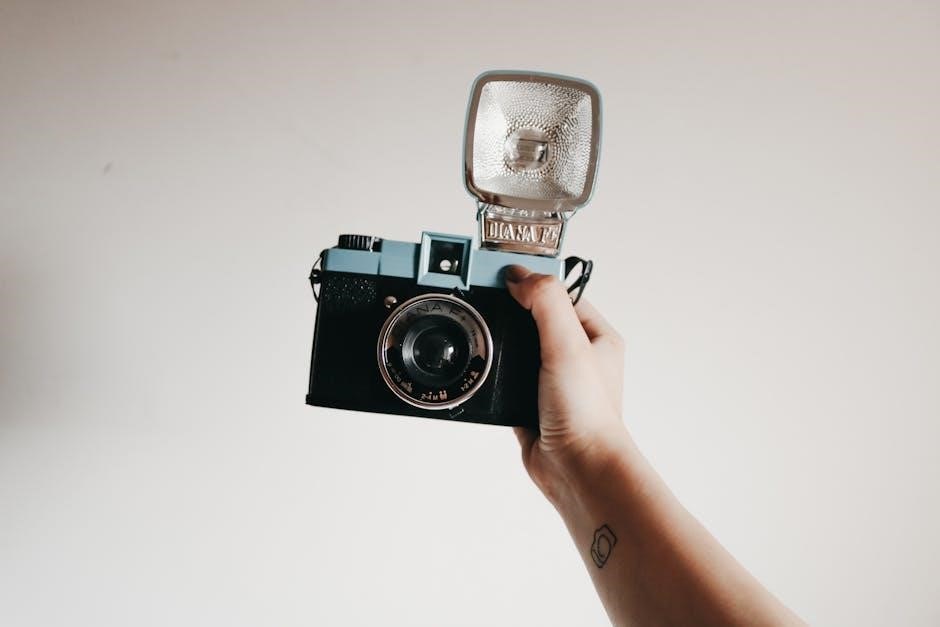Mastering manual photography basics with a handy cheat sheet helps you understand exposure, aperture, and shutter speed for better control over your photos and creative results.
Understanding the Basics of Manual Mode
Manual mode empowers photographers to take full control over their camera settings, allowing precise adjustments to achieve desired results. It requires understanding the exposure triangle—ISO, aperture, and shutter speed—to balance light and create visually appealing images. Unlike automatic modes, Manual mode lets you independently adjust each setting, ensuring creativity and flexibility. A manual photography cheat sheet can simplify learning these fundamentals, helping you master the basics and confidently capture stunning photos tailored to your artistic vision.
Why Use Manual Mode for Better Control Over Photos
Manual mode offers unparalleled control over your camera, enabling precise adjustments to ISO, aperture, and shutter speed. This allows you to tailor each setting to your creative vision, ensuring your photos look exactly as intended. Unlike automatic modes, Manual mode empowers you to make intentional decisions, resulting in sharper, more dynamic images. A manual photography cheat sheet can guide you in mastering these settings, helping you achieve professional-quality photos with ease and confidence.

The Exposure Triangle
ISO controls light sensitivity, adjusting brightness in photos. Lower ISOs (100-400) suit bright lighting, minimizing noise, while higher ISOs (1600+) handle low light but may add grain.
ISO: Understanding Its Role in Photography
ISO controls your camera’s light sensitivity, adjusting image brightness. Lower ISOs (100-400) are ideal for bright lighting, minimizing noise, while higher ISOs (1600+) handle low light but may introduce grain. Base ISO (often 100) ensures optimal quality, but raising it helps in dark conditions. Use high ISO sparingly to avoid noisy photos, as grain can degrade image quality. Balancing ISO with aperture and shutter speed is key for achieving desired results without compromising detail or sharpness.
Aperture: Controlling Depth of Field
Aperture, measured in f-stops, regulates light entry and depth of field. A wide aperture (low f-stop) creates a shallow focus, blurring backgrounds, while a narrow aperture (high f-stop) sharpens both foreground and background. For portraits, use wide apertures like f/2.8 to isolate subjects. For landscapes, narrow apertures like f/11 keep everything sharp. Adjusting aperture allows creative control over focus areas, balancing light intake with desired depth of field effects to enhance your photos’ visual appeal and storytelling impact.
Shutter Speed: Capturing Motion and Sharpness
Shutter speed determines how long the camera’s shutter stays open, impacting motion and sharpness. Faster speeds (1/1000s) freeze action, ideal for sports or wildlife, while slower speeds (1/10s) create motion blur, adding artistic effects. For sharp handheld shots, use speeds of 1/125s or faster. Slower speeds require tripods to avoid blur. Balancing shutter speed with aperture and ISO ensures well-exposed images, whether capturing dynamic movement or crisp, static subjects, allowing photographers to creatively control light and motion in their photos effectively.
Mastering Depth of Field
Depth of field controls focus in your photos, from sharp backgrounds to blurry foregrounds. Adjust aperture to achieve desired effects, enhancing creativity in your photography compositions effectively.
How Aperture Affects Background Blur
A low f-stop value creates a wide aperture, resulting in a shallow depth of field. This emphasizes your subject by blurring the background, as seen in portraits. Conversely, a high f-stop narrows the aperture, keeping more of the image in focus, ideal for landscapes. Adjusting aperture allows you to control background blur creatively, enhancing the visual appeal of your photos by isolating subjects or capturing detailed scenes.

When to Use Wide vs Narrow Aperture
Use a wide aperture (low f-stop) for portraits to blur the background and highlight your subject. Narrow apertures (high f-stop) are ideal for landscapes or group photos to keep everything sharp. A wide aperture is also great for low-light conditions, letting more light in, while narrow apertures are perfect for bright days to avoid overexposure. Experiment with these settings to achieve the desired depth of field and lighting in your photos.

White Balance in Manual Photography
Master white balance to eliminate unwanted color casts and enhance your photos. Adjust settings creatively to achieve neutral tones or artistic effects, ensuring your images look their best.
Understanding and Adjusting White Balance
White balance ensures accurate colors by removing unwanted tints. It adjusts how your camera interprets light, offering presets like Daylight, Tungsten, and Shade. Experimenting with these settings creatively can enhance your photos by producing unique effects, such as adding warmth or cool tones. Using the right white balance preset or custom settings helps achieve natural-looking results, while manual adjustments allow for artistic freedom. This control is essential for capturing scenes as they appear or creating distinct moods in your imagery.

Creative Uses of White Balance Settings
Creative white balance adjustments can transform your photos. Use Tungsten on overcast days for a moody blue tone or Shade during sunsets to enhance golden hues. Experimenting with different presets allows you to create unique artistic effects, adding emotional depth to your images. This technique lets you break free from standard settings, making your photography stand out with distinctive styles and moods that captivate viewers and express your creative vision.

Practical Steps to Start Shooting in Manual Mode
Switch to Manual mode on your camera. Adjust ISO, aperture, and shutter speed to achieve desired effects. Use a cheat sheet for quick reference and guidance.
Setting Up Your Camera for Manual Mode
To set up your camera for Manual mode, start by switching the mode dial to ‘M.’ Familiarize yourself with the ISO, aperture, and shutter speed controls. Use the cheat sheet to understand their functions. Adjust the ISO based on lighting conditions, with lower values for bright settings and higher for low light; Set the aperture to control depth of field, using a wide aperture for a blurry background or a narrow one for sharp focus. Finally, choose the shutter speed to freeze or blur motion, ensuring it aligns with your creative vision. Practice these adjustments to master Manual mode effectively.

A Step-by-Step Guide to Adjusting Settings
Locate the mode dial and switch it to ‘M’ for Manual. Adjust the aperture first to achieve your desired depth of field, then set the shutter speed to freeze or blur motion; Fine-tune the ISO to balance brightness without introducing noise. Refer to your cheat sheet for guidance. Take test shots and review the exposure to ensure accuracy. Make adjustments as needed to achieve the perfect balance of settings for your creative vision. This step-by-step approach ensures control and precision in capturing stunning images in Manual mode.
Troubleshooting Common Issues
Address exposure problems by adjusting aperture, shutter speed, or ISO. Use a cheat sheet to identify solutions for underexposed or overexposed shots and minimize unwanted noise effectively.
Fixing Exposure Problems
Exposure issues can make photos too bright or dark. Use your camera’s histogram to check for blown highlights or underexposed areas. To fix overexposure, reduce ISO, lower aperture, or increase shutter speed. For underexposed shots, increase ISO, widen aperture, or slow shutter speed. A cheat sheet helps you quickly adjust settings. Balancing the exposure triangle ensures well-lit images. Practice these steps to master manual mode and achieve professional results consistently.
Minimizing Noise and Grain
Noise and grain can ruin even the best photos. To minimize these issues, use the lowest possible ISO, as high ISOs introduce grain. Ensure proper exposure by adjusting aperture and shutter speed. Avoid underexposing, as correcting it later amplifies noise. Shoot in RAW for better post-processing control. Use noise reduction tools in editing software, but apply them sparingly to maintain detail. A cheat sheet can guide you to optimal settings, helping you capture clean, professional images with minimal noise and grain.
Mastery of manual photography comes with practice. Use your cheat sheet as a guide, experiment with settings, and refine your skills for stunning results. Keep shooting!

Final Tips for Mastering Manual Photography
Consistently practice and experiment with manual mode to refine your skills. Use a cheat sheet as a guide to quickly reference settings. Start by understanding the exposure triangle and how ISO, aperture, and shutter speed interact. Experiment with different combinations to see how they affect your photos. Review your images to identify areas for improvement. Over time, you’ll develop muscle memory and confidence, enabling you to capture stunning shots with ease and creativity.

Encouragement to Keep Practicing
Don’t be discouraged by initial challenges—mastering manual photography takes time. Each shot is a learning opportunity, so keep experimenting and reviewing your results. Use a cheat sheet to simplify the process and build confidence. Celebrate small victories, like nailing the perfect exposure or achieving your desired depth of field. With consistent practice, you’ll unlock the full creative potential of manual mode and capture stunning photos that reflect your unique vision. Stay patient, persistent, and passionate about your photography journey.